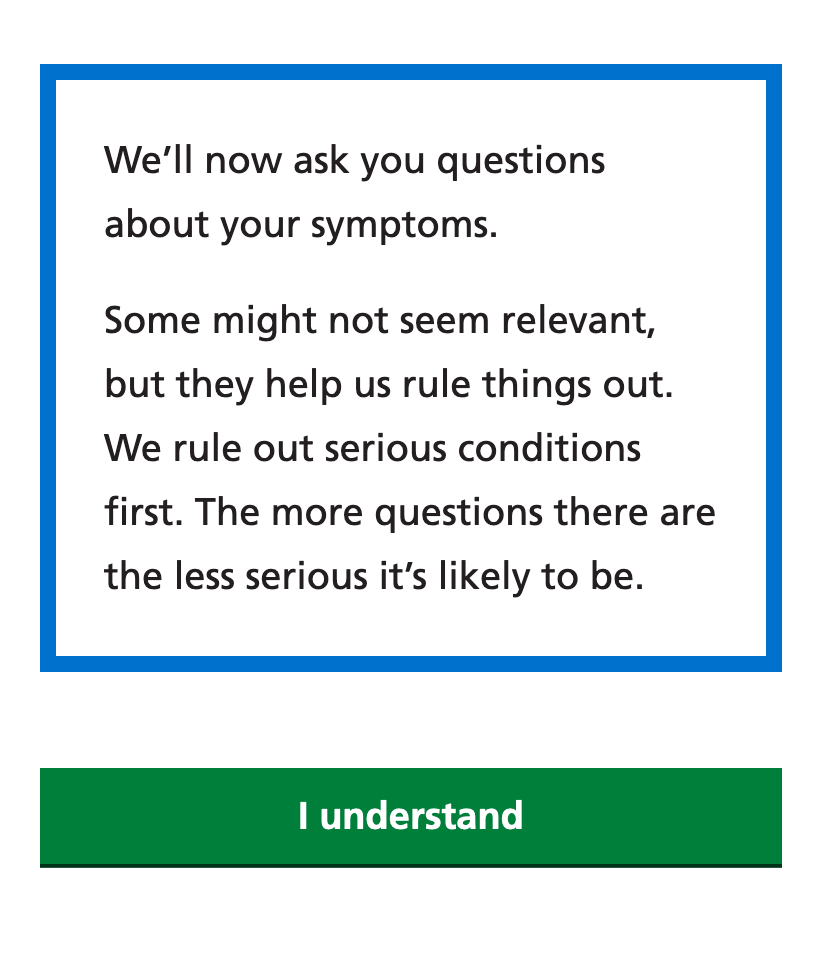The NHS 111 online service asks people a series of questions based on their symptoms to help them decide what to do next — should I see my doctor, go to accident and emergency, or is it okay to look after this myself?
I guess every post I write about 111 online will start with that. Anyway, sometimes there can be a lot of questions.
One of the things we’d noticed over time both from observing users and from apocryphal tales, is that after a certain point, people get frustrated by having to answer so many questions.
It just asks you a million questions then tells you to stay at home, I mean, what use is that?
Apocryphal users
The thing about NHS Pathways is that it rules out the most serious possibilities first. If you find yourself answering only one or two questions, the likelihood is that Pathways wants you to get some help rather quickly.
In contrast, if you find yourself wading through what feels like an endless barrage of seemingly random questions, that’s good news — it’s probably not very serious at all.
So why not share this knowledge? Why not expose a bit of the workings of this service to give users some perspective? Can we reduce frustration for users who are moving into lower and lower acuity as they answer questions?
Taking a pause
At the point you start answering Pathways questions you’ve:
- ruled out a 999 emergency
- told us roughly where you are
- told us your age and sex
- found an appropriate pathway
You’ve put in some work already. So at this point, why not pause for breath? Let’s set out what’s next with a message:
We’ll now ask you questions about your symptoms.
Some might not seem relevant, but they help us rule things out. We rule out serious conditions first. The more questions there are the less serious it’s likely to be.

What happened?
In labs and popups when we slotted in our interruption, people would pause, grunt a bit, nod, then continue through their journey without complaint. We took that as a good omen.
When we introduced “weird questions” to the live service, dropouts went down (and have stayed down) by 10%. On a national service that’s not insignificant.
Thoughts
Experience and perceived wisdom tells us to rigorously minimise journeys. The less we can ask the better. The leaner the content the better. The fewer clicks the better — “don’t make me think!”
This is a good rule of thumb. Without rigour and reduction everything descends into noise. For examples see most commercial website homepages ever.
But being able to interrupt the user at a significant point in their journey in order to provide orientation and set some expectation is a very powerful tool. It should go without saying that tools like this need to be used extremely sparingly and with care. For examples of interruption that have become blunt through overuse see most commercial website homepages ever.
Another aspect of “weird questions” is the honesty of exposing an aspect of the inner workings of a system (Pathways) to users in a simple way. There’s sometimes a demonstrable benefit in explanation in opposition to a “magic computer stuff is going on” approach.
Credit
This totally wasn’t my idea. It came from Lauren McAllister our senior content designer. Imagine what kind of asshole would write a post like this then not namecheck eh? I left it right till the end though. Perhaps, dear reader, you won’t have got this far.